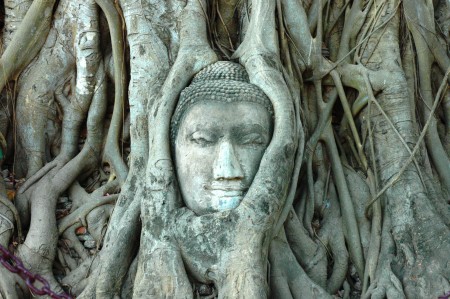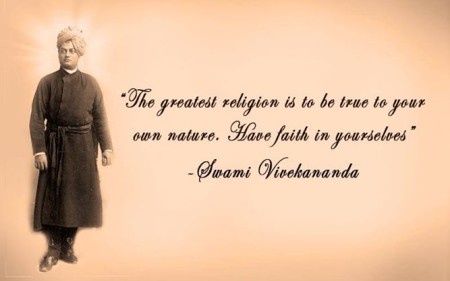The word Yoga is synonymous with Truth, One-ness, Samadhi, Nirvana, or Moksha. Oftentimes today the term Yoga is used to describe what is in fact Hatha Yoga or Yoga Asana and Pranayama etc. That is, a series of physical postures (asanas) and other techniques that are part of a Hatha/Raja Yoga practice.
However, Yoga is the end rather than the means.
The means to attain Yoga are accepted to be four in number and they are known as Raja Yoga, Jnana Yoga, Bhakti Yoga, and Karma Yoga (more explanation of these is given below).
An analogy to express Yoga is given below in the story of the Ocean and the Wave – or read another version of the same story on our blog.
Practices such as Hatha Yoga etc. are preparatory activities bringing the mind and body into alignment and synchronization; developing strength and flexibility to enable you to sit in meditation; also the discipline and self-control required for this. They are not intended as ‘exercise’ in the way they are often approached and taught today, though there are many benefits for the body and mind from regular practice. These physical and mental benefits can be considered ‘side effects’ of your practice and although they are not the primary purpose of the practice there is no reason not to experience and enjoy these benefits.
A Hatha Yoga practise may utilise asana (posture), pranayama (control of Prana usually through breathing techniques), mudra (hand positions), mantra (chanting), banda (locks in the body), meditation, and relaxation. Various rituals and cleansing activities are also taught along with diet and life-style approaches.
The word Yoga is derived from the Sanskrit word yuj which means ‘to join’. Yoga is a means to bring unity and harmony to the body, mind and emotions; and in spiritual terms a means to bring about the union of the individual consciousness with the universal consciousness. For the Wave to realise it is and was always the Ocean (see the short article below).
Different Yogic philosophies discuss many paths to achieve Yoga (or Self Realisation) and it is understood that all paths lead to the same endless Ocean. Understanding this we are free of judgment of ourselves and others. We all have our own path.
All systems of Yoga are based on developing our awareness and learning to respect and accept who we are. This Body and Mind of ours is an instrument to marvel, to understand, and to care for. It may not be perfect but it is what is required for us. The more we understand and care for this unique instrument the better we can manage our life and realise our purpose. When we do not accept ourselves and others we suffer. The cause of all suffering is ignorance. Knowledge is that which can remove suffering. This same Body and Mind that experiences this suffering is the very same instrument that will allow us to experience the Self that is Truth. So the call comes to “Wake Up” and not to waste the opportunity this life has given you.
The four divisions of Yoga:
The following are brief notes on Yoga taken from booklets from Swami Vivekananda [these books are listed and available on our online shop.
Jnana Yoga
Jnana Yoga is the philosophy of Vedanta, it is neither optimistic or pessimistic, it takes things as they are and shows that the basis of our being is contradiction, that wherever there is good there must be evil, wherever there is life there must be death, that the fire that cooks our food may also burn us, and so on. Good and bad are never different things but one and the same, the difference is simply one of degree. Jnana Yoga teaches us that the path to religion and wisdom is renunciation. Knowing the state of things gives us more patience and respect for different customs and less fanaticism. We realise that the only thing that is certain is that in time all rivers will reach the ocean, their goal, and attain freedom. The Vedantist goes beyond nature, beyond Maya, beyond a personal Truth, to discover Truth is he himself, the one real Self, and is free. Maya is described by Swami Vivekananda as “simply a statement of facts about the universe as it exists”. Vedanta allows absolute religious freedom and stops nowhere, it is understood that freedom is the requirement for growth.
Advaita Vedanta is non-duality, Oneness, and a rationalistic religion that can reach and take hold of intellectuals. Advaita is non-destructive and does not disturb the faith of anyone, instead helps all to evolve and understand a Truth that is One and total, that the whole world and all in it is Truth, good and bad, life and death, the child, the husband, the wife. Have what you want, only know the truth of it and realise it. Give up desires, give up the illusory world, once there is no more delusion, we see Oneness and there is no more misery – this misery comes from ignorance, from separation. Vedanta says that this separation is unreal; it does not exist. Truth is in all work, all desires, all thoughts. All is Truth. All is One.
Karma Yoga
Karma Yoga is the path of action or work, everything we do, physical or mental, is Karma, and it leaves its marks or impressions on us. Yet only what we earn and what we deserve will be what is really ours and what we can assimilate and achieve. Karma Yoga is work for works sake, without selfish motivation, without attachment to the fruits of that action, without caring for the results. According to the circumstances in which we are placed, we must perform our duties. We should go about these duties without fear, without weakness. Karma Yoga is to do the duty that is ours by birth, not to judge the duty of others through our own eyes and culture. Through this work with the sense of duty will come work without any idea of duty – work will become worship.
Raja Yoga
Raja Yoga is the path of meditation providing the scientific and practical methodology to acquire the subtle perceptions required to reach Truth. It does not deny the existence of facts that may be difficult to explain, and it warns us that attributing such facts to supernatural beings will bring dependence and spiritual decay, fear and superstition. It teaches that all knowledge is based upon experience and Yoga is the science that teaches us about religion, that allows us to experience Truth for ourselves, to realise and know truth, not simply follow that which our forefathers tell us is so. Raja Yoga teaches the method to this understanding, this experience. It shows us how to observe the internal states, how to direct the power of attention, how to analyse the mind, how to concentrate to obtain knowledge. This knowledge is that which takes away misery. No faith or belief is necessary to study Raja Yoga, it never asks what our religion is. We are human beings and have the right to seek religion and have our questions answered by ourselves. Raja Yoga teaches us to believe nothing until we have found it out for ourself. Anything that is presented as secret or mysterious in these systems of Yoga should be rejected. Discard all things that weaken you, strength is vital. It takes much effort to concentrate and to move inwards and study the mind, it takes time and constant practice – some of this practice is physical but most is mental.
Raja Yoga is divided into eight steps as follows: Yama: such behaviour as non-violence, truthfulness; Niyama: such behaviours as cleanliness, contentment, self-study, surrender to Truth, and sustained practice; Asana: postures (“any posture that is easy and steady is an Asana”) *; Pranayama: management and control of Prana (breathing exercises may be involved here but Prana is not breath, Prana is the vital life force); Pratyahara: withdrawal of the senses within; Dharana: concentration and fixing the focus on a single spot without distraction; Dhyana: Meditation that is all encompassing; Samadhi: Bliss, Truth, One-ness. Once we reach Dhyana and prepare the foundations we continue to practise and the experience of Samadhi will come when the time is right.
*It may be seen that Asana is that which is similar to Hatha Yoga but it should be realised that Hatha Yoga is a very physical practice to make the body strong and healthy and to live long, it takes a long time to achieve much spiritual growth and practices can be difficult. In Raja Yoga asana is mainly to achieve a firm seat or foundation, to purify the nerves, and keep the spine column free and straight and the chest open.
Bhakti Yoga
Bhakti Yoga is the path of devotion and love – complete surrender to Truth. It is a real and genuine search for Truth that begins, continues, and ends in Love. The Bhakta (devotee) understands that all sects of all religions are manifestations of the same Truth. He does not hate or criticise but has sympathy and appreciation for all. Truth is worshipped by all sects in all names and through all forms. The Bhakta takes care of the food he eats, as this is what determines his physical and mental structure; the passions are controlled; purity and cleanliness of both the external and internal is maintained with discrimination. The Bhakta must be strong and cheerful with a steady and peaceful mind.
In all Yogas renunciation is necessary and this is the heart of religion. The Karma-Yogi’s renunciation is in giving up the fruits of his action and any rewards; the Raja-Yogi’s renunciation comes by understanding that he in fact is not nature but spirit through all eternity; the Jnana-Yogi’s renunciation is to realise from the very beginning that the whole of solid looking nature is an illusion, and by the force of his rational conviction break away from bondage with nature. The renunciation of the Bhakta comes more naturally without any sense of giving up or separation. Instead, as devotion to Truth grows and intensifies; forms, rituals, books, religions, and all limitations and bondages fall off by their own nature. There is no suppressing of emotions, only a growing intensity as they are all directed to Truth. Bhakti fills the heart with the ocean of love and there is no attachment or room for anything but Truth, all shines with this beauty and love and there are no more distinctions, no resentments, no jealousy, selfishness, or hate. Through Love the Reality beyond is understood.
In Bhakti Yoga the feelings and passions of humans are not considered wrong – it is understood they must be carefully controlled and move in the highest direction and that is toward Truth. By loving Truth and because everything is Truth it is possible to experience universal love. All rivers flow to the ocean and all Love is given to Truth, its highest source. Pain, misery, death – all will be welcomed as they come from the Beloved. Love manifests itself as reverence, pleasure in Truth, and misery from not attaining Truth. Love seeks no reward or return, it knows no fear, and has no rival. The Bhakta becomes mad with the divine love of Truth and the universe melts into the infinite ocean of Love. Man is transformed in the presence of this Love and finally he realises that Love, The Beloved, and the Lover are One.
Ayurveda and Yoga:
Ayurveda is the knowledge of the Self and the management of one’s Prakriti or ‘essential constitution’ for the entire span of one’s life. Ayurveda and Hatha Yoga practices become very much intertwined and in fact share a common philosophy called Sankhya. Understanding individual differences helps us to understand what Yoga path and practise will be most supportive and compatible to each person. We work continuously using the knowledge and tools that Ayurveda provides to prepare the field (the Body and Mind) and develop stability and firmness in order to reach the state of Yoga.
Why so many different ‘types’ of Hatha Yoga?
We may become confused about all the names given to different styles and approaches to yoga such as Hatha, Ashtanga/Power, Iyengar, Bikram/Hot, Integral, Kundalini, Dru, Vinyasa, Jivamukti, and so on!!
All these are different variations and names of Hatha Yoga. Each teacher has his/her own ideas about how they use the this philosophy so they introduce variations based on their own personal understanding and experiences. This is also due partly to the concepts of trademarking and commercialism. Why a certain yoga school or teacher becomes more popular than others is due mainly to marketing and trends and to the popularity and charisma of certain individual teachers. The key here is not to get ‘stuck’ in the teachings but to remember these are all tools and ideas introduced to obtain certain results, once they are no longer needed then the attitude should be ‘if they are there fine, if they are not there fine’.
Yoga and the Ocean
As an analogy, we can compare Yoga to that of the Ocean; as a vast body of water; endless and eternal. In the Ocean all is one and never separate though there are often Waves. We can compare these Waves to the human birth and the ego that makes us feel we are separate to others. As soon as we feel this separation we suffer all the limitations and fear of associating ourselves with the individualised Body and Mind, of being the Wave and not the Ocean. We become stuck there, and we forget that we have always been the Ocean. There are many Waves but they are never separate from the Ocean, and it is only due to Karma/Maya we (the Body and the Mind) assume the form of Waves.
Identifying and practising seriously an appropriate technique to attain Yoga will help us re-connect and re-unite to the Ocean that we are and have always been. The practice will help us develop discipline and equanimity, allowing us to realise our potential and our true Self beyond the Body and the Mind. Nevertheless we must understand, control, and manage the Body and the Mind as instruments to experience the Self that is Truth. These are the only tools we are given to allow us to experience that which we are here to experience in this life span.
Learn more about Ayurveda.
Read about Kundalini Yoga, Meditation, and Breathing Classes (classes offered at our Blenheim Centre).



